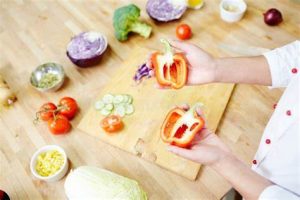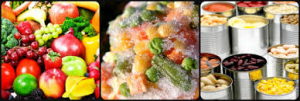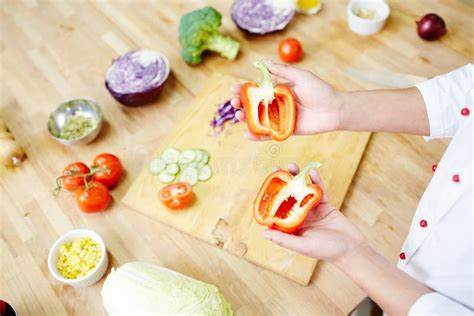
Choosing between fresh, frozen, and canned produce doesn’t have to be an all-or-nothing decision. In fact, it’s possible to create diverse and nutritious meals by striking a balance between these options. In this article, we’ll provide tips on how to combine fresh, frozen, and canned produce to ensure variety, nutrition, and budget-friendliness in your diet.
The Art of Balancing
Balancing fresh, frozen, and canned produce allows you to enjoy the benefits of each, creating well-rounded, flavorful, and nutritious meals. Here’s how to master this art:
1. Prioritize Fresh Ingredients
While frozen and canned options offer convenience and cost savings, fresh produce is your ticket to superior taste and texture. Here’s how to incorporate fresh ingredients effectively:
- Salads: Fresh lettuce, spinach, arugula, and various herbs add vibrancy to salads. Mix them with your choice of canned or frozen veggies.
- Sides: Serve fresh vegetables as sides or additions to your main courses. Roast or steam them to preserve nutrients and enhance flavor.
- Smoothies: Fresh fruits like berries, bananas, and citrus create a burst of flavor in your morning smoothie.
- Snacking: Opt for fresh produce as a crunchy, healthy snack. Sliced cucumbers, carrot sticks, or apple wedges are delightful choices.

https://thumbs.dreamstime.com/b/fresh-ingredients-halves-ripe-red-pepper-hands-chef-over-table-assortment-fresh-vegetables-cooking-113994309.jpg
2. Leverage Frozen Convenience
Frozen produce offers year-round availability and extended shelf life. Here’s how to use it effectively:
- Smoothies: Frozen fruits, like berries and mango chunks, are perfect for smoothies. They provide natural sweetness and a refreshing chill.
- Stir-Fries: Frozen stir-fry mixes are a quick and healthy solution for busy nights. Add them to your favorite protein source and sauce for a complete meal.
- Soup and Stew Bases: Frozen vegetables such as peas, corn, and mixed vegetables work wonderfully as bases for soups and stews.
- Baking: Use frozen fruits in baking, from blueberries in muffins to mixed berries in pies.
3. Embrace Canned Versatility
Canned produce offers long shelf life and budget-friendliness. Here’s how to make the most of it:
- Sauces and Salsas: Canned tomatoes and peppers are excellent for making homemade sauces, salsas, and chilis.
- Beans and Legumes: Canned beans, lentils, and chickpeas are a protein-packed, time-saving addition to salads, soups, and casseroles.
- Quick Sides: Canned vegetables like corn and green beans can be quickly heated and served as sides.
- Fruit Salad: Create a fruit salad with canned fruits, like pineapple, mandarin oranges, and pears. Add fresh berries for a colorful twist.
4. Mix and Match Creatively
The key to balancing fresh, frozen, and canned produce is to mix and match creatively. Experiment with various combinations to create exciting and nutritious dishes:
- Layered Parfaits: Combine fresh berries, canned peaches, and frozen yogurt for a delightful parfait.
- Mediterranean Bowls: Mix fresh cucumber and tomatoes with canned olives and feta for a Mediterranean-inspired bowl.
- Tropical Smoothie Bowls: Top your frozen mango and banana smoothie bowl with fresh kiwi and canned pineapple.
- Bowl of Greens: Create a hearty salad by layering fresh lettuce, canned artichoke hearts, and roasted frozen sweet potato chunks.
5. Pay Attention to Storage
Proper storage is crucial to maintain the quality of your produce:
- Fresh Produce: Keep fresh produce in the crisper drawer of your refrigerator and use or consume it before it starts to wilt.
- Frozen Produce: Store frozen produce in your freezer, making sure it’s sealed tightly to prevent freezer burn.
- Canned Produce: Keep canned goods in a cool, dry place, and check for any damage to cans before use.

https://anaprdotcom.files.wordpress.com/2016/04/canned-fresh-frozen-vegetables.png
6. Plan Your Meals Ahead
Meal planning allows you to strategically incorporate fresh, frozen, and canned produce into your weekly menu. Consider planning your meals based on what you have on hand to minimize food waste.
7. Stay Mindful of Labels
When buying canned produce, pay attention to labels. Choose low-sodium or no-added-sugar options whenever possible to make your meals healthier.
8. Experiment and Enjoy the Journey
Balancing fresh, frozen, and canned produce is a culinary journey that can be as exciting as it is nutritious. Embrace experimentation, try new recipes, and savor the different textures and flavors each type of produce brings to your dishes.
In Conclusion: A Delicious Balance
Balancing fresh, frozen, and canned produce in your diet is a delightful journey that allows you to enjoy the best of all worlds. It offers convenience, nutrition, and budget-friendliness. By creatively combining these options, planning your meals, and staying mindful of storage and labels, you can create a well-rounded, delicious, and nutritious diet that’s accessible year-round and friendly to your wallet.










